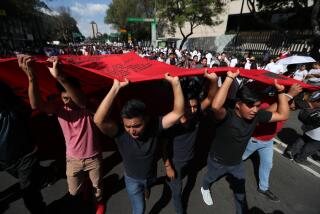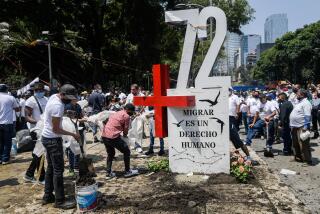360 Snipers Shot at Students in ‘68, Mexican Inquiry Finds
- Share via
MEXICO CITY — A criminal inquiry into a 1968 massacre of student protesters has found evidence that at least 360 snipers apparently under government command opened fire into the crowd and that some of the gunmen passed through the apartment of a relative of Mexico’s interior minister.
The evidence, disclosed Wednesday on the eve of the 35th anniversary of the killings, could advance a special prosecutor’s effort to bring homicide charges against former officials for one of Mexico’s pivotal tragedies of recent decades.
It also indicates that the scale of the operation to crush the Oct. 2 protest in Mexico City’s Tlatelolco Plaza was bigger than previously believed and gives credence to witness accounts that the number of deaths was as high as 300, far above the official toll of 38.
Snipers were evident at the time, firing from rooftops and windows into a crowd of 10,000 people, “but we had no idea there were so many,” said Maria de los Angeles Magdaleno, head of the prosecutor’s research team.
Mexican historians have concluded that the killings, 10 days before the opening of the 1968 Olympic Games here, were ordered at the highest levels of government with the intent to suppress student unrest that might embarrass the leaders of what was then essentially a one-party state. The students were agitating for greater political freedom.
Magdaleno said in an interview that her team’s search of newly declassified government archives on the event had yet to produce evidence of such high-level orders.
But she said it found documents showing that snipers who fired into the plaza from surrounding residential towers passed through the apartment of Rebeca Zuno de Lima, a sister-in-law of then-Interior Minister Luis Echeverria. Reports on the shooting from military officers stationed in the apartment were found in Interior Ministry archives, Magdaleno said.
Echeverria, who went on to serve as president from 1970 to 1976, has denied over the years that he played a role in the shootings. Summoned last year by special prosecutor Ignacio Carrillo Prieto, he cited his constitutional right to remain silent.
But according to newly released U.S. State Department and CIA documents, Echeverria created and led a working group of Mexican officials to deal with the student protests, which had begun in July 1968, and predicted days before the massacre that “the situation would be under control very shortly.”
The U.S. documents were obtained recently by Kate Doyle of the National Security Archive, a private research organization based in Washington.
Magdaleno said the evidence her team uncovered in Mexico further discredits the 81-year-old former president’s denials.
“How could he not have known in advance about an operation that made use of his sister-in-law’s apartment?” she said.
The 1968 massacre opened a violent era in Mexican history. President Vicente Fox, whose election in 2000 ended 71 years of rule by the Institutional Revolutionary Party, appointed Carrillo to investigate those killings and the slayings of at least 275 leftist dissidents by government forces over the 15 years that followed.
Carrillo said in a recent interview that he hoped by the end of the year to conclude his investigation into the Tlatelolco killings. “It won’t be a few” who face criminal charges, he said. “It’s not five, not 10, but more.”
The data disclosed by the prosecutor’s researchers Wednesday include evidence that Manuel Diaz Escobar, then the leader of a secret police battalion known as the Falcons and now a target of the investigation, was present in Tlatelolco plaza at the time of the shootings.
Also disclosed was a list of the intelligence officers for dozens of military and police units that turned up at the scene -- another sign, Magdaleno said, that senior government officials knew about the attack in advance.
Magdaleno said military records reported the detention of 360 snipers, apparently paramilitary fighters, in the aftermath of the shootings. The gunmen were turned over to civilian authorities, she said, but because they apparently worked for the government were never prosecuted.
“We lost their trail,” she said.
Mexicans plan marches today, as they do every year, commemorating the massacre. As Fox visited Aguascalientes state Tuesday, student teacher Citlali Huerta held up a paper reading, “Oct. 2 is not forgotten.”
“What year?” Fox asked her, according to an account published in La Jornada newspaper.
“1968,” she said. “I was a little girl.”
“And you haven’t forgotten it?” the president said. “Neither have I!”
More to Read
Sign up for Essential California
The most important California stories and recommendations in your inbox every morning.
You may occasionally receive promotional content from the Los Angeles Times.









